Mandy Moore's Blog, page 7
February 20, 2019
WWW: Studying Stretch; Art in Puerto Rico; Beaded Knitting
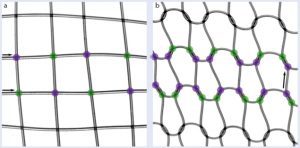 What do earthquakes, robotics and jumpers have in common? Samuel Poincloux completed his PhD by studying how the stretch a knitted fabric is rooted in mechanics.
What do earthquakes, robotics and jumpers have in common? Samuel Poincloux completed his PhD by studying how the stretch a knitted fabric is rooted in mechanics.
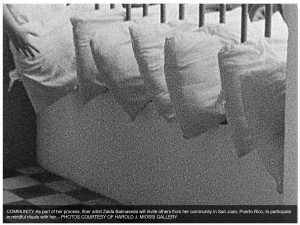 The Topologies of Excess: A Survey of Contemporary Practices from Puerto Rico is on display at Cuesta College’s Harold J. Miossi Gallery (San Luis Obispo, CA) through Feb. 24.
The Topologies of Excess: A Survey of Contemporary Practices from Puerto Rico is on display at Cuesta College’s Harold J. Miossi Gallery (San Luis Obispo, CA) through Feb. 24.
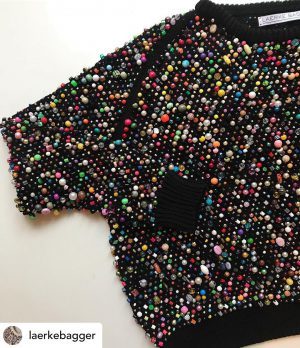 If you are into beaded knitting, this jumper from instagram user @laerkebagger is inspiring! I agree with our Editor, It’s almost like looking at a universe of stars and planets from very far away. Such a labor of love.
If you are into beaded knitting, this jumper from instagram user @laerkebagger is inspiring! I agree with our Editor, It’s almost like looking at a universe of stars and planets from very far away. Such a labor of love.
Loading…
The post WWW: Studying Stretch; Art in Puerto Rico; Beaded Knitting appeared first on knittyBlog.

February 19, 2019
Spinning Classes Aren’t Just for Big Fiber Shows
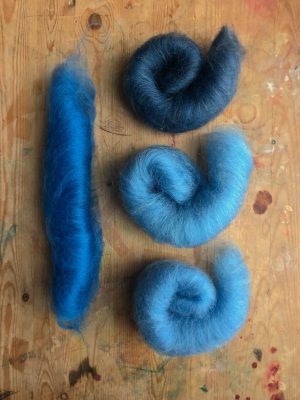 Tint, tone and shade blended from a gorgeous blue.
Tint, tone and shade blended from a gorgeous blue.If you are looking for in-person spinning classes and there are no big fiber festivals near you, do not despair!
I get questions about where to find classes from newer spinners especially.
Every spinner I’ve met has a dream about going to Rhinebeck or Maryland Sheep and Wool, but there are A LOT of middle sized and small fiber shows across the country. Knitter’s Review still has the best list that I’ve found for all types of fiber shows.
Look for local and not quite local guilds. Spinning guilds bring in teachers on the regular, a lot of these don’t advertise much outside of their guild, so you need to do some google-sleuthing. If you are a newer spinner, joining a guild is a great way to meet other spinners and get all of your burning spinning questions answered.
Knitting shops and retreats. Spinning continues to attract knitters who are interested in playing with fiber and making exactly the yarn they want to knit. I’ve been getting lots of request to teach spinning for knitters at yarn shops and retreats over the past couple of years. Ask your local shop to bring in a spinning teacher.
Weaving retreats. Weavers and spinners have been learning side by side forever. Weaving retreats and conferences usually have spinning classes too. I spent years being intimidated by weaving conferences, they seem so advanced and, well, mathy. I discovered there are weaving classes of all levels and types, plus many other fiber arts classes.
Artists studios. A fiber artist that has a studio is probably already teaching classes, and having other teachers in to play.
Several events where I’m teaching have opened for registration recently. Come take a class from me!
MidAtlantic Fiber Association Conference
Susan’s Fiber Retreat (this is coming up fast)
Kalamazoo Fiber and Dye Studio
The post Spinning Classes Aren’t Just for Big Fiber Shows appeared first on knittyBlog.

February 13, 2019
WWW: Life-size Crochet; Textile Art; Planning and Fast Fashion
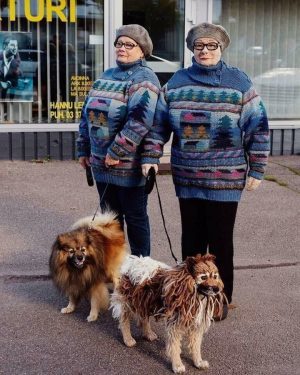 Two takes on life size knit and crochet projects, first the inside — an anatomically correct skeleton by artist shanell papp. The second is by yarn artist Liisa Hietanen, of villagers in her Hämeenkyrö, Finland town. Her ability to capture the likeness is inspiring.
Two takes on life size knit and crochet projects, first the inside — an anatomically correct skeleton by artist shanell papp. The second is by yarn artist Liisa Hietanen, of villagers in her Hämeenkyrö, Finland town. Her ability to capture the likeness is inspiring.
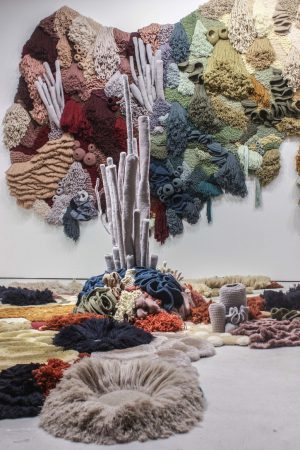 At vogue.com, they explore the work of a few fascinating textile artists, including Vanessa Barragão. Her tapestries are oceanic and naturalistic-inspired works that reflect themes of climate change, the perils of conspicuous consumption, and a celebration of the natural world.
At vogue.com, they explore the work of a few fascinating textile artists, including Vanessa Barragão. Her tapestries are oceanic and naturalistic-inspired works that reflect themes of climate change, the perils of conspicuous consumption, and a celebration of the natural world.
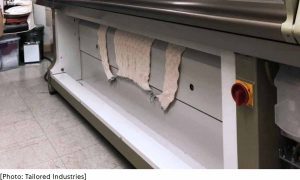 Fashion’s trash problem is partly a planning problem. This Brooklyn (USA) company is trying to (machine) knit on demand to help reduce piles of unwanted garments.
Fashion’s trash problem is partly a planning problem. This Brooklyn (USA) company is trying to (machine) knit on demand to help reduce piles of unwanted garments.
The post WWW: Life-size Crochet; Textile Art; Planning and Fast Fashion appeared first on knittyBlog.

February 12, 2019
Spinner-Worthy Yarn: Liverpool Yarns
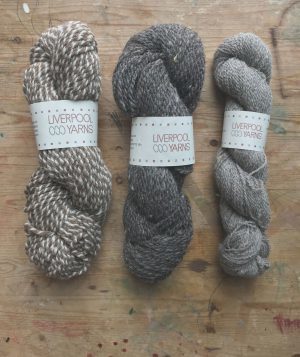 Liverpool Yarns, L to R Chunk, Worsted, Fingering.
Liverpool Yarns, L to R Chunk, Worsted, Fingering.Just because I spin yarn doesn’t mean I have stopped buying commercially spun yarn. No way! I love using all types of yarn, handspun is my favorite, but carefully sourced and spun smaller batch yarns are a close second. Some folks call these farm to needle yarn, I call them spinner-worthy.
To me a spinner-worthy yarn has a few specific things that make it a yarn worth looking at. It’s really the main things that I think about when I spin a yarn: the fiber and where it comes from, the spinning process – is it woolen or worsted spun (and I love to know about the mill), and intention in the ply to complement the other components for the widest variety of projects.
It’s also about the people. These yarns always have the best people behind them. People who put thought and care into the yarn, the sheep, and their employees. Many of these yarns can be only bought directly from the folks that make them, but not all. You might be surprised how many of the yarns in your LYS are spinner-worthy.
I’ll be highlighting spinner-worthy yarns here and on my own blog. Let me know if you know a yarn you’d like me to consider featuring.
Liverpool Yarns is Colleen Puckett, Erika Flory and a flock of Shetland sheep. Yes, that’s right Liverpool
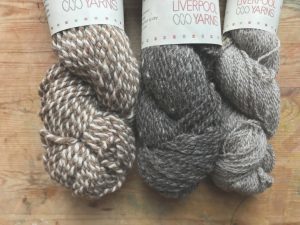 Liverpool Yarns close, L to R Chunky, Worsted, Fingering. I knit the middle one.
Liverpool Yarns close, L to R Chunky, Worsted, Fingering. I knit the middle one.Yarns is 100% Shetland. The fiber is sourced from their own flock and selected UK Shetland fiber. The yarn comes in three weights fingering, worsted and chunky. The women of Liverpool Yarns were kind enough to send me one skein of each weight, and I chose the worsted to swatch.
The colors of Liverpool Yarns are all natural Shetland colors, they get variation in color by mixing the different browns, creams and greys, as well as having a yarn marled in the ply. The effect is a wide variety of earthy tones that pair wonderfully with each other. The color I knit is Bramble, a mixture of a brown-grey and dark brown. The colors were blended with a light hand in the preparation and that gives it a great tweedy look.
The yarn is a 2-ply, worsted spun, and is quite squishy. There is no excess lanolin in the yarn, it wasn’t sticky at all. The ply is just enough, maybe a step to the light side. My knitting needles did find their way between the plies a couple of times. But I will take that light ply over a tighter one if it helps to give me, light springy yarn which this is. There was hay still in the yarn, which I don’t mind at all; it mostly fell out while I was knitting.
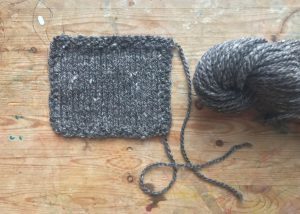 Swatch Liverpool Yarns, worsted, Bramble.
Swatch Liverpool Yarns, worsted, Bramble.The knitted fabric is so good. Before I was done knitting, I was muttering ,”I want a sweater”. The grist is about 770 yards per pound. I would need about 9 skeins to make a plain-vanilla cardigan, which is a two-pound sweater, average weight.
The yarn bloomed a little after a blocking soak. I really like how the randomness of the color blending makes a tweedy fabric that is not uniform. I could just wear it next to my skin, but would wear it more often with a layer between sweater and skin. The swatch is sturdy but not prickly. It feels like fabric that would last. I can imagine it being one of those cardigans that goes everywhere with me. I wouldn’t have to be concerned if it fell on the ground or lived for a week or two in the messy back seat of my car. I could stuff it in my carry on and it would spring to life when I needed to wear it, and both knitters and spinners would want to touch it.
100% Shetland wool
Worsted spun
2-ply
170 yards/100 grams
17-19 sts = 4″ on US size 5-7 (3.75-4.5mm) needles
Hand wash in cool water, lay flat to dry
$25 US
February 6, 2019
WWW: digitized archives for hats & chromatics; meet purl
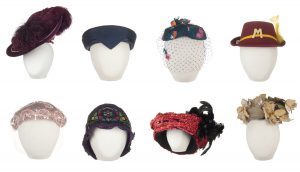 Want to view an archive of vintage hats without going outside? Now you can because the Minnesota Historical Society has unveiled a vast digital archive. Stephanie Olson, a Minnesota Historical Society collections associate has digitized 717 women’s hats from their massive collections, making images of their brims and grand embellishments available to the public.
Want to view an archive of vintage hats without going outside? Now you can because the Minnesota Historical Society has unveiled a vast digital archive. Stephanie Olson, a Minnesota Historical Society collections associate has digitized 717 women’s hats from their massive collections, making images of their brims and grand embellishments available to the public.
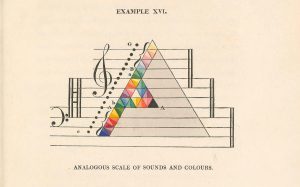 Continuing in the digitized archive theme, “Chromatics” (1817) describes an early color system stressing harmony & analogy, including the relationship between color and music! (h/t Jillian!)
Continuing in the digitized archive theme, “Chromatics” (1817) describes an early color system stressing harmony & analogy, including the relationship between color and music! (h/t Jillian!)
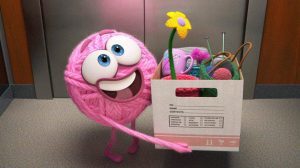 Meet Purl… the star of a new pixar short.
Meet Purl… the star of a new pixar short.
Knitty is for everyone. Are you interested in getting your pattern or tutorial published in Knitty? Please check out the recently revised Submissions Guidelines.
The post WWW: digitized archives for hats & chromatics; meet purl appeared first on knittyBlog.

February 5, 2019
Working on a Knitting Kit
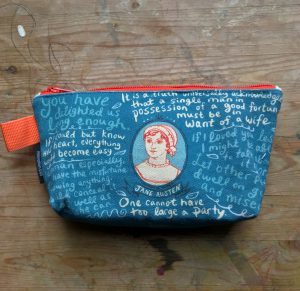 The Jane Austen Bag from the Unemployed Philosophers Guild
The Jane Austen Bag from the Unemployed Philosophers GuildI am still happy with the Everyday Spin Kit I put together two years ago, with all of my spinning essentials, plus a few things that I might need. I’ve decided that as a spinning knitter I’m now in need of an updated knitting kit. I don’t want it to be as big as my spin kit, but I want more than will fit in my old (and broken down) 4″x4″ notions bag.
I started with the bag. I’ve been looking for a use for this Jane Austen bag from the Unemployed Philosophers Guild since I got it. She now has a purpose. It’s a ziptop bag, 5″x9″, with a 2″ gusset at the bottom, so it will stand. Happily my life now has more Jane ‘I esteem him’ Austen.
I moved everything from my smaller knit kit, into this bag and added a few things that usually roam the bottom of my project bags.
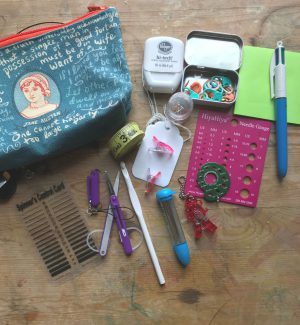 My current kit
My current kitHere’s what I have right now. I do notice how tired some of my tools are, I need to freshen up a few things.
I have:
dental floss
stitch markers
sticky notes
pen
needle gauges
scissors/snips
tags
Clover clips
measuring tape
crochet hook
WPI gauge
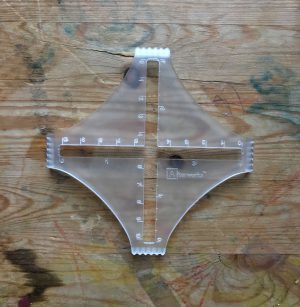 Akerworks Swatch Gauge
Akerworks Swatch Gauge
Right after I took that photos I noticed , my Akerworks Swatch Gauge was missing. It was in the company of a project that’s in timeout due to gauge issues.
There are a few things I know I want to add, a twist angle gauge, a small notebook, a smaller crochet hook, and non-greasy hand lotion.
Before you ask, I use the dental floss for emergency stitch markers, to tie dropped stitches to fix later, as a lace lifeline, and to tie skeins that I don’t want to wind.
What am I missing? What tools do you have in your knitting kit that you use all of the time?
The post Working on a Knitting Kit appeared first on knittyBlog.

January 30, 2019
WWW: a second life for public art projects; crochet prodigy; Tla’amin baskets + maths
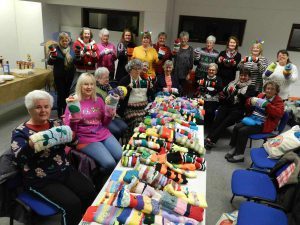 Remember the twiddle-mitts sensory aid for dementia patients I posted a few weeks ago? A knitting group recycled yarn bomb projects into 187 cuffs!
Remember the twiddle-mitts sensory aid for dementia patients I posted a few weeks ago? A knitting group recycled yarn bomb projects into 187 cuffs!
 11 year old Jonah loves to crochet. He learned at age 5. Jonah gives me hope for the future!
11 year old Jonah loves to crochet. He learned at age 5. Jonah gives me hope for the future!
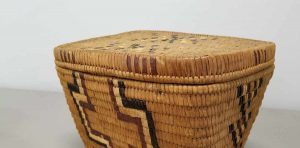 The Callysto Salish Basket project at Simon Fraser University in Canada is a collaborative project that explores the functional mathematical beauty of the Tla’amin Nation baskets in a digital learning resource.
The Callysto Salish Basket project at Simon Fraser University in Canada is a collaborative project that explores the functional mathematical beauty of the Tla’amin Nation baskets in a digital learning resource.
The post WWW: a second life for public art projects; crochet prodigy; Tla’amin baskets + maths appeared first on knittyBlog.

January 29, 2019
A Tip to Save a Bit of Fiber
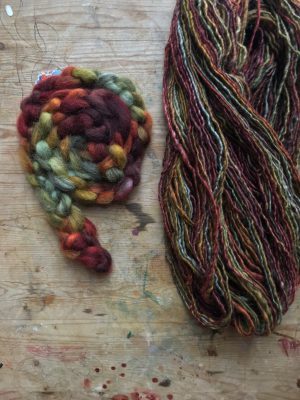 Nest Fiber Studio Chasing Deer on mixed BFL.
Nest Fiber Studio Chasing Deer on mixed BFL.The easiest answers to spinning troubles are my favorite.
When I spin a dyed braid I like to save a narrow strip of unspun fiber to have a record of the fiber’s colors before I spin it. What usually happens is I find that strip sometime during the spinning and spin it into my yarn. I’ve never found a good way to differentiate the piece of fiber.
Scrolling through Instagram one morning I saw that Alanna Wilcox (spinnybuns) has the perfect simple solution. Chain that strip of fiber fiber. So smart and so easy.
The chained fiber lets me know this is something other than fiber to spin, and hopefully I won’t spin it. I can study the color pattern as I chain it and take a moment to decide (again) how I want the colors to play out in my yarn. Plus the tiny chain is so cute!
The fiber in the photo is from Nest Fiber Studio. I talked about it in more depth on my personal blog last week.
The post A Tip to Save a Bit of Fiber appeared first on knittyBlog.

January 23, 2019
WWW: knitted games; weaving tradition to regain purpose; sustainability in fashion
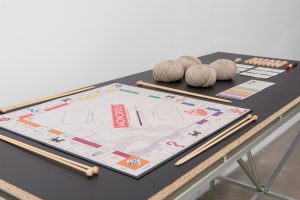 Last week we learned about an 8-bit gold embroidered computer and the yarn recorder. This week I invite you to knit monopoly. Or if you prefer mystery knits, this year’s MIT Mystery Hunt included a knitting clue. [thank you for the link A!]
Last week we learned about an 8-bit gold embroidered computer and the yarn recorder. This week I invite you to knit monopoly. Or if you prefer mystery knits, this year’s MIT Mystery Hunt included a knitting clue. [thank you for the link A!]
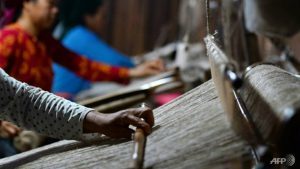 In this article, One stitch at a time: Weaving rehab for Vietnam trafficking victims, we visit a textile cooperative in northern Vietnam’s Quan Ba district. It provides hope, income, and purpose to women of the Vietnamese Hmong hill tribes many of whose lives have been blighted by people trafficking while also preserving the local tradition of weaving.
In this article, One stitch at a time: Weaving rehab for Vietnam trafficking victims, we visit a textile cooperative in northern Vietnam’s Quan Ba district. It provides hope, income, and purpose to women of the Vietnamese Hmong hill tribes many of whose lives have been blighted by people trafficking while also preserving the local tradition of weaving.
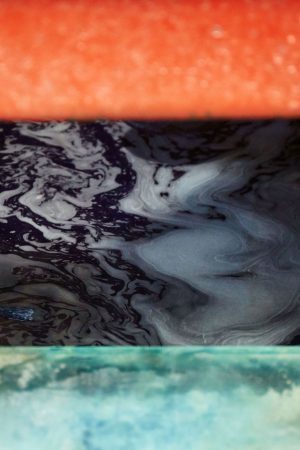 A jeans factory in Vietnam is making environmentally safe blue jeans by recycling its waste water, utlizing solar power, and more.
A jeans factory in Vietnam is making environmentally safe blue jeans by recycling its waste water, utlizing solar power, and more.
The post WWW: knitted games; weaving tradition to regain purpose; sustainability in fashion appeared first on knittyBlog.

January 22, 2019
What if Fiber Labels Were More Like Yarn Labels?
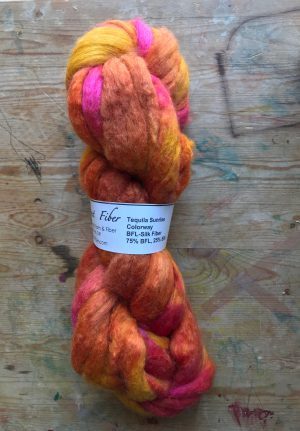 Abstract Fiber BFL/Silk, Tequila Sunrise
Abstract Fiber BFL/Silk, Tequila SunriseLately I’ve been thinking about what information is helpful to know before I start to spin a commercial braid of fiber. That led me to thinking, “What if Fiber Labels Were More Like Yarn Labels
Yarn labels have lots of useful information for knitters. Granted, knitters are mostly trying to do one thing, hit that mighty gauge number, but the information on the the label helps then know what their fabric will be like.
Spinners are working with a more open road, as far as the yarn we’ll make.
Looking at a recent fiber purchase and comparing the label to a yarn label, I pondered what other information I’d want on a fiber label.
The minimum bits information that fiber labels have are:
Dyer
Fiber/blend
Weight of fiber
Colorway name
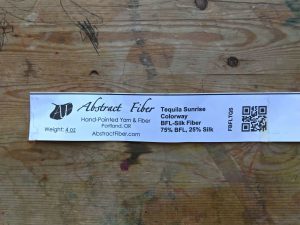 Abstract Fiber label
Abstract Fiber label Here’s are other things I’d find helpful:
Preparation – Some combed tops are so lofty and uncompressed that I can’t always tell right away if it’s top or roving, especially if it’s a blend. I’ve noticed lately that some dyers call top, roving. I’ve bought some of it online with equal parts hope and doubt in my heart. It comes and it’s top, disappointing, but not surprising.
Plus, the difference between top and roving can be very confusing for new spinners.
Micron Count – I’m not sure this is readily available to dyers. Maybe fiber wholesalers can help with the information? This helps me, beyond my fingers, to judge the fineness of a fiber. My fingertips aren’t as sensitive as they used to be, and if it’s camping/gardening season, they aren’t sensitive at all.
Staple Length – I’d love this to be measured by the dyer, rather than pulled from a website or a book using a breed average, because staple length varies greatly between sheep, flocks and years. The fiber most dyers have are giant bumps (50lbs-100 lbs) of a breed or blend. Pulling a staple and measuring it before dyeing would be hard, but it would be one more thing to do. Knowing staple length is important for drafting consistently.
Those are my three today. What would you add to the list?
The post What if Fiber Labels Were More Like Yarn Labels? appeared first on knittyBlog.

Mandy Moore's Blog
- Mandy Moore's profile
- 6 followers



